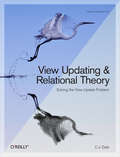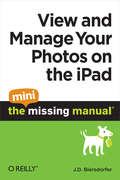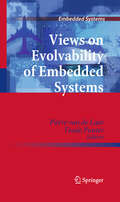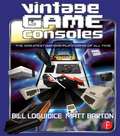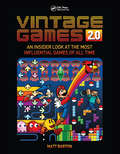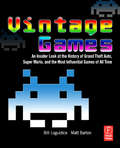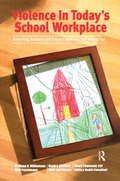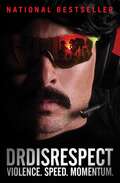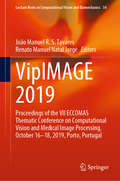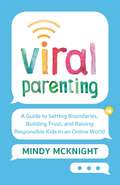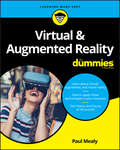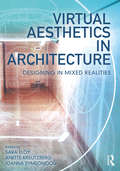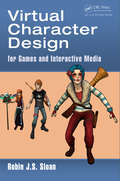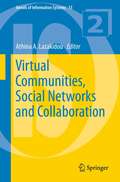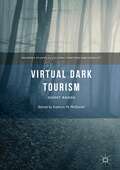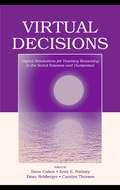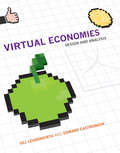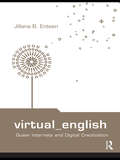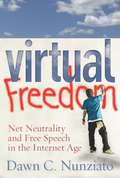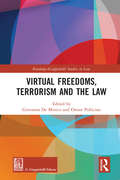- Table View
- List View
View Updating and Relational Theory: Solving the View Update Problem
by C. J. DateViews are virtual tables. That means they should be updatable, just as "real" or base tables are. In fact, view updatability isn’t just desirable, it’s crucial, for practical reasons as well as theoretical ones. But view updating has always been a controversial topic. Ever since the relational model first appeared, there has been widespread skepticism as to whether (in general) view updating is even possible.In stark contrast to this conventional wisdom, this book shows how views, just like base tables, can always be updated (so long as the updates don’t violate any integrity constraints). More generally, it shows how updating always ought to work, regardless of whether the target is a base table or a view. The proposed scheme is 100% consistent with the relational model, but rather different from the way updating works in SQL products today.This book can:Help database products improve in the futureHelp with a "roll your own" implementation, absent such product improvementsMake you aware of the crucial role of predicates and constraintsShow you how relational products are really supposed to behaveAnyone with a professional interest in the relational model, relational technology, or database systems in general can benefit from this book.
View and Manage Your Photos on the iPad, The Mini Missing Manual
by David Pogue J. D. BiersdorferEverything you need to get your photos on your iPad
View and Manage Your Photos on the iPad: The Mini Missing Manual
by J. D. BiersdorferOne of the iPad's big pluses is its beautiful, high-resolution display. That makes it a perfect way to stroll down memory lane-from the comfort of your armchair. View and Manage Your Photos on the iPad: The Mini Missing Manual shows you how to import, organize, and enjoy your photos using clear, jargon-free explanations and step-by-step instructions.You'll learn to create slideshows complete with your own soundtrack and transitions, connect your tablet to a big-screen TV so you can gather the family around, turn your slab into a digital picture frame (a great idea when you recharge your 'Pad), use a treasured photo as your wallpaper, and share your images with friends by attaching one--or many-pics to a message.You'll also learn how to import your images into the iPad using iTunes' easy syncing feature, how to pull pictures off of email messages and into your tablet's photo album, and how to import pictures directly from your camera.In short, this Mini Missing Manual tells you everything you need to know to view and manage your photos on your iPad.
Views on Evolvability of Embedded Systems
by Pierre Van de Laar Teade PunterEvolvability, the ability to respond effectively to change, represents a major challenge to today's high-end embedded systems, such as those developed in the medical domain by Philips Healthcare. These systems are typically developed by multi-disciplinary teams, located around the world, and are in constant need of upgrading to provide new advanced features, to deal with obsolescence, and to exploit emerging enabling technologies. Despite the importance of evolvability for these types of systems, the field has received scant attention from the scientific and engineering communities. Views on Evolvability of Embedded Systems focuses on the topic of evolvability of embedded systems from an applied scientific perspective. In particular, the book describes results from the Darwin project that researched evolvability in the context of Magnetic Resonance Imaging (MRI) systems. This project applied the Industry-as-Laboratory paradigm, in which industry and academia join forces to ensure continuous knowledge and technology transfer during the project's lifetime. The Darwin project was a collaboration between the Embedded Systems Institute, the MRI business unit of Philips Healthcare, Philips Research, and five Dutch universities. Evolvability was addressed from a system engineering perspective by a number of researchers from different disciplines such as software-, electrical- and mechanical engineering, with a clear focus on economic decision making. The research focused on four areas: data mining, reference architectures, mechanisms and patterns for evolvability, in particular visualization & modelling, and economic decision making. Views on Evolvability of Embedded Systems is targeted at both researchers and practitioners; they will not only find a state-of-the-art overview on evolvability research, but also guidelines to make systems more evolvable and new industrially-validated techniques to improve the evolvability of embedded systems.
Vintage Game Consoles: An Inside Look at Apple, Atari, Commodore, Nintendo, and the Greatest Gaming Platforms of All Time
by Bill Loguidice Matt BartonVintage Game Consoles tells the story of the most influential videogame platforms of all time, including the Apple II, Commodore 64, Nintendo Entertainment System, Game Boy, Sega Genesis, Sony PlayStation, and many more. It uncovers the details behind the consoles, computers, handhelds, and arcade machines that made videogames possible. Drawing on extensive research and the authors’ own lifelong experience with videogames, Vintage Game Consoles explores each system’s development, history, fan community, its most important games, and information for collectors and emulation enthusiasts. It also features hundreds of exclusive full-color screenshots and images that help bring each system’s unique story to life. Vintage Game Consoles is the ideal book for gamers, students, and professionals who want to know the story behind their favorite computers, handhelds, and consoles, without forgetting about why they play in the first place – the fun! Bill Loguidice is a critically acclaimed technology author who has worked on over a dozen books, including CoCo: The Colorful History of Tandy’s Underdog Computer, written with Boisy G. Pitre. He’s also the co-founder and Managing Director for the popular Website, Armchair Arcade. A noted videogame and computer historian and subject matter expert, Bill personally owns and maintains well over 400 different systems from the 1970s to the present day, including a large volume of associated materials. Matt Barton is an associate professor of English at Saint Cloud State University in Saint Cloud, Minnesota, where he lives with his wife Elizabeth. He’s the producer of the "Matt Chat," a weekly YouTube series featuring in-depth interviews with notable game developers. In addition to the original Vintage Games, which he co-authored with Bill, he’s author of Dungeons & Desktops: The History of Computer Role-Playing Games and Honoring the Code: Conversations with Great Game Designers.
Vintage Games 2.0: An Insider Look at the Most Influential Games of All Time
by Matt BartonSuper Mario Bros. Doom. Minecraft. It’s hard to imagine what life would be like today without video games, a creative industry that now towers over Hollywood in terms of both financial and cultural impact. The video game industry caters to everyone, with games in every genre for every conceivable electronic device--from dedicated PC gaming rigs and consoles to handhelds, mobile phones, and tablets. Successful games are produced by mega-corporations, independent studios, and even lone developers working with nothing but free tools. Some may still believe that video games are mere diversions for children, but today’s games offer sophisticated and wondrously immersive experiences that no other media can hope to match. Vintage Games 2.0 tells the story of the ultimate storytelling medium, from early examples such as Spacewar! and Pong to the mind blowing console and PC titles of today. Written in a smart and engaging style, this updated 2nd edition is far more than just a survey of the classics. Informed by hundreds of in-depth personal interviews with designers, publishers, marketers, and artists--not to mention the author’s own lifelong experience as a gamer--Vintage Games 2.0 uncovers the remarkable feats of intellectual genius, but also the inspiring personal struggles of the world’s most brilliant and celebrated game designers--figures like Shigeru Miyamoto, Will Wright, and Roberta Williams. Ideal for both beginners and professionals, Vintage Games 2.0 offers an entertaining and inspiring account of video game’s history and meteoric rise from niche market to global phenomenon. Credit for the cover belongs to Thor Thorvaldson.
Vintage Games: An Insider Look at the History of Grand Theft Auto, Super Mario, and the Most Influential Games of All Time
by Bill Loguidice Matt BartonVintage Games explores the most influential videogames of all time, including Super Mario Bros., Grand Theft Auto III, Doom, The Sims and many more. Drawing on interviews as well as the authors' own lifelong experience with videogames, the book discusses each game's development, predecessors, critical reception, and influence on the industry. It also features hundreds of full-color screenshots and images, including rare photos of game boxes and other materials. Vintage Games is the ideal book for game enthusiasts and professionals who desire a broader understanding of the history of videogames and their evolution from a niche to a global market.
Violence in Today's School Workplace: Protecting Teachers and School Employees in a Violent Age
by Diane H. Williamson David E. Strecker Henry TownsendIncreasingly, headlines today report out-of-control student violence occurring in our schools and colleges. Yet so little concrete action is being taken to protect the bystanding victims of this trauma, the school worker. Classroom teachers, administrators, coaches, school bus drivers, cafeteria workers, custodians, and other school employees a
Violence. Speed. Momentum.
by Dr DisrespectToo much power. Wow. Too much energy. Wow. Too much anticipation. WOW. It&’s the nationally bestselling memoir from the biggest star in gaming: Dr Disrespect.Dr Disrespect is a 6-foot-8 freak of nature with a 37-inch vertical, the two-time, back-to-back 1993–94 Blockbuster Video Game Champion, and in his factual opinion, the most dominant international gaming superstar in the history of the world. It was just a matter of time before Western civilization came begging Doc to save literature by writing a memoir that reads like a vicious, muscular lion clawing his way through the rocks, roaring in anger and dominance. Here you will find his deepest, most intimate secrets. The untold history of his mysterious, legendary origins and his rise to unparalleled dominance. And most of all, you will find out what, exactly, Doc&’s a doctor of. Are you ready for a book with the rhythm of a sleazy &’70s muscleman and the ruthlessness of a &’90s serial killer? A journey that stares down the long, dark alley of your fears and never looks back? Does your warrior&’s heart yearn to reach the tippity top of the mountain just to realize you&’re still only halfway up? If so, firm handshakes, Champion: Welcome to the salvation of literature.
VipIMAGE 2019: Proceedings of the VII ECCOMAS Thematic Conference on Computational Vision and Medical Image Processing, October 16–18, 2019, Porto, Portugal (Lecture Notes in Computational Vision and Biomechanics #34)
by João Manuel R. S. Tavares Renato Manuel Natal JorgeThis book gathers full papers presented at the VipIMAGE 2019—VII ECCOMAS Thematic Conference on Computational Vision and Medical Image Processing—held on October 16-18, 2019, in Porto, Portugal. It discusses cutting-edge methods, findings, and applications related to 3D vision, bio- and medical imaging, computer-aided diagnosis, image enhancement, image processing and analysis, virtual reality, and also describes in detail advanced image analysis techniques, such as image segmentation and feature selection, as well as statistical and geometrical modeling. The book provides both researchers and professionals with extensive and timely insights into advanced imaging techniques for various application purposes.
Viral BS: Medical Myths and Why We Fall for Them
by Seema YasminDissecting the biggest medical myths and pseudoscience, Viral BS explores how misinformation can spread faster than microbes.Can your zip code predict when you will die? Should you space out childhood vaccines? Does talcum powder cause cancer? Why do some doctors recommend e-cigarettes while other doctors recommend you stay away from them? Health information—and misinformation—is all around us, and it can be hard to separate the two. A long history of unethical medical experiments and medical mistakes, along with a host of celebrities spewing anti-science beliefs, has left many wary of science and the scientists who say they should be trusted. How do we stay sane while unraveling the knots of fact and fiction to find out what we should really be concerned about, and what we can laugh off? In Viral BS, journalist, doctor, professor, and CDC-trained disease detective Seema Yasmin, driven by a need to set the record straight, dissects some of the most widely circulating medical myths and pseudoscience. Exploring how epidemics of misinformation can spread faster than microbes, Dr. Yasmin asks why bad science is sometimes more believable and contagious than the facts. Each easy-to-read chapter covers a specific myth, whether it has endured for many years or hit the headlines more recently. Dr. Yasmin explores such pressing questions as• Do cell phones, Nutella, or bacon cause cancer?• Are we running out of antibiotics?• Does playing football cause brain disease?• Is the CDC banned from studying guns?• Do patients cared for by female doctors live longer? • Is trauma inherited?• Is suicide contagious?and much more.Taking a deep dive into the health and science questions you have always wanted answered, this authoritative and entertaining book empowers readers to reach their own conclusions. Viral BS even comes with Dr. Yasmin's handy Bulls*%t Detection Kit.
Viral Hate: Containing Its Spread on the Internet
by Christopher Wolf Abraham H. FoxmanEmboldened by anonymity, individuals and organizations from both left and right are freely spewing hateful vitriol on the Internet without worrying about repercussions.Lies, bullying, conspiracy theories, bigoted and racist rants, and calls for violence targeting the most vulnerable circulate openly on the web.And thanks to the guarantees of the First Amendment and the borderless nature of the Internet,governing bodies are largely helpless to control this massive assault on human dignity and safety. Abe Foxman and Christopher Wolf expose the threat that this unregulated flow of bigotry poses to the world.They explore how social media companies like Facebook and YouTube, as well as search engine giant Google, are struggling to reconcile the demands of business with freedom of speech and the disturbing threat posed by today's purveyors of hate. And they explain the best tools available to citizens, parents, educators, law enforcement officers, and policy makers toprotect thetwin values of transparency and responsibility. As Foxman and Wolf show, only an aroused and engaged citizenry can stop the hate contagion before it spirals out of control - with potentially disastrous results.
Viral Parenting: A Guide to Setting Boundaries, Building Trust, and Raising Responsible Kids in an Online World
by Mindy McKnightMindy McKnight, YouTube's favorite mom, shares the tools parents need to keep kids safe in their online lives--and shows how to create stronger family relationships as they do. A cross between Jen Hatmaker and Rosalind Wiseman, VIRAL PARENTING is a guide to raising responsible, safe, and communicative kids in the digital world. Mindy shares practical tools for having honest conversations with kids of all ages about privacy, bullying, respectfulness, and family time, while emphasizing the importance of trust and open communication. These strategies are timeless--whether applied to texting, snapping, Facebooking, kiking, or whatever social media platforms await us in the future, this book is ultimately about teaching children about personal responsibility and safety. Mindy shares practical tools for creating family rules for kids of all ages about privacy, bullying, respectfulness, and family time, while emphasizing the importance of trust and open communication. Using family contracts, guided conversations, device checks, and respectful but firm oversight, the McKnights have raised a close knit family and navigated the complexity of being world-wide internet celebrities with grace. McKnight will show any parent of any child or teen how that's done--setting non-negotiable guidelines and offering a savvy perspective toward privacy that audience have been begging for.
Viren in allen Dimensionen: Wie ein Informationscode Viren, Software und Mikroorganismen steuert
by Rafael BallMikroorganismen, Viren und Computerprogramme codieren alle Informationen, die erforderlich sind, sich selbst zu vermehren und verbreiten. Dabei sind sich diese Mechanismen in der belebten Welt, in der Welt der Viren und sogar in der Welt der technischen Systeme verblüffend ähnlich. Das Buch zeigt auf, wie groß die Parallelen dieser verschiedenen belebten und unbelebten replizierenden Systeme sind und worauf sie basieren. Der Ausflug führt ebenso in die faszinierende Welt der Genetik, zur Frage, was Leben definiert und in die Programmierung von Software, die sich selbständig vervielfacht. Schließlich wird daraus die Frage abgeleitet, ob und inwieweit solche sich selbst replizierenden technischen Systeme genauso gefährlich werden können wie infektiöse Viren bei der Auslösung von Pandemien, wie etwa der Corona-Pandemie im Jahr 2020.
Virtual & Augmented Reality For Dummies
by Paul MealyAn easy-to-understand primer on Virtual Reality and Augmented Reality Virtual Reality (VR) and Augmented Reality (AR) are driving the next technological revolution. If you want to get in on the action, this book helps you understand what these technologies are, their history, how they’re being used, and how they’ll affect consumers both personally and professionally in the very near future. With VR and AR poised to become mainstream within the next few years, an accessible book to bring users up to speed on the subject is sorely needed—and that’s where this handy reference comes in! Rather than focusing on a specific piece of hardware (HTC Vive, Oculus Rift, iOS ARKit) or software (Unity, Unreal Engine), Virtual & Augmented Reality For Dummies offers a broad look at both VR and AR, giving you a bird’s eye view of what you can expect as they continue to take the world by storm. * Keeps you up-to-date on the pulse of this fast-changing technology * Explores the many ways AR/VR are being used in fields such as healthcare, education, and entertainment * Includes interviews with designers, developers, and technologists currently working in the fields of VR and AR Perfect for both potential content creators and content consumers, this book will change the way you approach and contribute to these emerging technologies.
Virtual Aesthetics in Architecture: Designing in Mixed Realities
by Sara Eloy Anette Kreutzberg Ioanna SymeonidouVirtual Aesthetics in Architecture: Designing in Mixed Realities presents a curated selection of projects and texts contributed by leading international architects and designers who are using virtual reality technologies in their design process. It triggers discussion and debate on exploring the aesthetic potential and establishing its language as an expressive medium in architectural design. Although virtual reality is not new and the technology has evolved rapidly, the aesthetic potential of the medium is still emerging and there is a great deal more to explore. The book provides a comprehensive overview of the current use of virtual reality technologies in the architectural design process. Contributions are presented in six parts, fully illustrated with over 150 images. Recent projects presented are distributed in five themes: introduction to mixed realities; space and form; context and ambiguity; materiality and movement; body and social. Each theme includes richly illustrated essays by leading academics and practitioners, including those from Zaha Hadid Architects and MVRDV, detailing their design process using data-driven methodologies. Virtual Aesthetics in Architecture expands the use of technology per se and focuses on how architecture can benefit from its aesthetic potential during the design process. A must-read for practitioners, academics, and students interested in cutting-edge digital design.
Virtual Character Design for Games and Interactive Media
by Robin James SloanWhile the earliest character representations in video games were rudimentary in terms of their presentation and performance, the virtual characters that appear in games today can be extremely complex and lifelike. These are characters that have the potential to make a powerful and emotional connection with gamers. As virtual characters become more
Virtual Communities, Social Networks and Collaboration
by Athina A. LazakidouOnline communities are among the most obvious manifestations of social networks based on new media technology. Facilitating ad-hoc communication and leveraging collective intelligence by matching similar or related users have become important success factors in almost every successful business plan. Researchers are just beginning to understand virtual communities and collaborations among participants currently proliferating across the world. Virtual Communities, Social Networks and Collaboration covers cutting edge research topics of utmost real-world importance in the specific domain of social networks. This volume focuses on exploring issues relating to the design, development, and outcomes from electronic groups and online communities, including: - The implications of social networking, - Understanding of how and why knowledge is shared among participants, - What leads to participation, effective collaboration, co-creation and innovation, - How organizations can better utilize the potential benefits of communities in both internal operations, marketing, and new product development.
Virtual Competition
by Ariel EzrachiAriel Ezrachi and Maurice Stucke take a hard look at today's app-assisted paradise of digital shopping. The algorithms and data-crunching that make online purchasing so convenient are also changing the nature of the market by shifting power into the hands of the few, with risks to competition, our democratic ideals, and our overall well-being.
Virtual Dark Tourism: Ghost Roads (Palgrave Studies In Cultural Heritage And Conflict )
by Kathryn N. McDanielThis book takes the concept of “dark tourism”—journeys to sites of death, suffering, and calamity—in an innovative yet essential direction by applying it to the virtual realms of literature, film and television, the Internet, and gaming. Essays focus both on the creative construction of imaginary journeys and the historiographic and civic consequences of such memorializations. From World War II time-travel novels to Game of Thrones, and from Internet reproductions of Rwandan genocide locations to invented tragedies in futuristic domains, authors from various fields examine the purpose and influence of simulated travels to morbid sites. Designed for a wide audience of scholars and travelers virtual and real, this volume raises awareness about the many pathways through which we encounter death experiences in contemporary society. What we know about the past—or, what we think we know about it—is shaped daily by such imagined journeys as these.
Virtual Decisions: Digital Simulations for Teaching Reasoning in the Social Sciences and Humanities
by Kent E. Portney Steve Cohen Dean Rehberger Carolyn ThorsenDevelopments in digital technologies--and in understandings of how best to use them--have altered teaching and learning environments, and stand to do so even more rapidly in the future. Virtual Decisions: Digital Simulations for Teaching Reasoning in the Social Sciences and Humanities focuses on the special issues related to the use of digital technologies in teaching the complex nature of social decisions, with particular attention to the use of digital role-play simulations as a means to accomplish this. With the advent of new technologies for delivering multimedia simulations to students, and advanced graphics capabilities to create life-like decision environments, digital role-play simulations are increasingly available for K-12 and higher education teachers to use in the classroom. This book helps both users and developers make intelligent choices about the value added by using simulations, technology, and media to teach reasoning in social sciences and humanities classrooms.The book relies on a four-part framework for developing a digital multimedia-based simulation approach, which represents: a cross-disciplinary method to describing simulations; the students who are using them; the educational setting in which they are used; and a rubric for assessing learning. The volume is divided into two parts. The first part presents a review of the theory and research detailing why didactic approaches do not or cannot address specific learning goals, as well as a description of the theoretical framework for using and developing simulations. The second part includes chapters on specific digital simulations and how they fit with the theoretical framework.Virtual Decisions fills a significant gap in the existing literature of instructional technology and is of interest to instructors, primarily in the social sciences and humanities, who are potential users of the simulations. It is also a resource for graduate students and pre-service teachers studying simulation design.
Virtual Economies: Design and Analysis (Information Policy)
by Edward Castronova Vili LehdonvirtaHow the basic concepts of economics—including markets, institutions, and money—can be used to create and analyze economies based on virtual goods.In the twenty-first-century digital world, virtual goods are sold for real money. Digital game players happily pay for avatars, power-ups, and other game items. But behind every virtual sale, there is a virtual economy, simple or complex. In this book, Vili Lehdonvirta and Edward Castronova introduce the basic concepts of economics into the game developer's and game designer's toolkits. Lehdonvirta and Castronova explain how the fundamentals of economics—markets, institutions, and money—can be used to create or analyze economies based on artificially scarce virtual goods. They focus on virtual economies in digital games, but also touch on serious digital currencies such as Bitcoin as well as virtual economies that emerge in social media around points, likes, and followers. The theoretical emphasis is on elementary microeconomic theory, with some discussion of behavioral economics, macroeconomics, sociology of consumption, and other social science theories relevant to economic behavior.Topics include the rational choice model of economic decision making; information goods versus virtual goods; supply, demand, and market equilibrium; monopoly power; setting prices; and externalities. The book will enable developers and designers to create and maintain successful virtual economies, introduce social scientists and policy makers to the power of virtual economies, and provide a useful guide to economic fundamentals for students in other disciplines.
Virtual English: Queer Internets and Digital Creolization (Routledge Studies in New Media and Cyberculture)
by Jillana B. EnteenVirtual English examines English language communication on the World Wide Web, focusing on Internet practices crafted by underserved communities in the US and overlooked participants in several Asian Diaspora communities. Jillana Enteen locates instances where subjects use electronic media to resist popular understandings of cyberspace, computer-mediated communication, nation and community, presenting unexpected responses to the forces of globalization and predominate US value systems. The populations studied here contribute websites, conversations and artifacts that employ English strategically, broadening and splintering the language to express their concerns in the manner they perceive as effective. Users are thus afforded new opportunities to transmit information, conduct conversations, teach and make decisions, shaping, in the process, both language and technology. Moreover, web designers and writers conjure distinct versions of digitally enhanced futures -- computer-mediated communication may attract audiences previously out of reach. The subjects of Virtual English challenge prevailing deployments and conceptions of emerging technologies. Their on-line practices illustrate that the Internet need not replicate current geopolitical beliefs and practices and that reconfigurations exist in tandem with dominant models.
Virtual Freedom
by Dawn C. NunziatoCommunications giants like Google, Comcast, and AT&T enjoy increasingly unchecked control over speech. As providers of broadband access and Internet search engines, they can control online expression. Their online content restrictions-from obstructing e-mail to censoring cablecasts-are considered legal because of recent changes in free speech law. In this book, Dawn Nunziato criticizes recent changes in free speech law in which only the government need refrain from censoring speech, while companies are permitted to self-regulate. By enabling Internet providers to exercise control over content, the Supreme Court and the FCC have failed to protect the public's right to access a broad diversity of content. Nunziato argues that regulation is necessary to ensure the free flow of information and to render the First Amendment meaningful in the twenty-first century. This book offers an urgent call to action, recommending immediate steps to preserve our free speech rights online.
Virtual Freedoms, Terrorism and the Law (Routledge-Giappichelli Studies in Law)
by Giovanna De MinicoThis book examines the risks to freedom of expression, particularly in relation to the internet, as a result of regulation introduced in response to terrorist threats. The work explores the challenges of maintaining security in the fight against traditional terrorism while protecting fundamental freedoms, particularly online freedom of expression. The topics discussed include the clash between freedom of speech and national security; the multijurisdictional nature of the internet and the implications for national sovereignty and transnational legal structures; how to determine legitimate and illegitimate association online; and the implications for privacy and data protection. The book presents a theoretical analysis combined with empirical research to demonstrate the difficulty of combatting internet use by terror organizations or individuals and the range of remedies that might be drawn from national and international law. The work will be essential reading for students, researchers and policy makers in the areas of Constitutional law; Criminal Law, European and International law, Information and Technology law and Security Studies.
